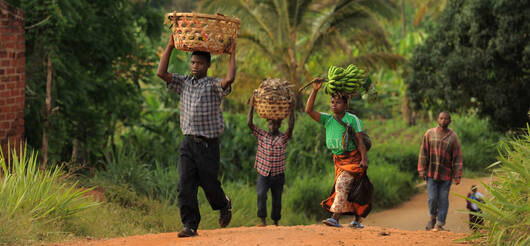Non-timber forest products (NTFPs) contribute significantly to a rural household's livelihood in the African semi-arid tropics. This study examines the income from NTFPs and the dependency on these of different socio-economic groups in Northern Benin. Using survey data from 230 households of two villages, we firstly compared incomes of five...
Case study on Climate Compatible Development (CCD) in agriculture for food security in Bangladesh
07 September 2015
07 September 2015
Climate compatible development (CCD) is a comprehensive approach of moving beyond the standalone conventional adaptation and mitigation initiatives, and focusing on long term resilient development considering the future projections on climate change. It is evidenced in recent studies and researches that the food security situation in Bangladesh is going to...
Integrated nutrition and food security strategies for children and vulnerable groups in Viet Nam
07 September 2015
07 September 2015
The MDG Achievement Fund was established in 2007 through a landmark agreement signed between the Government of Spain and the UN system. With a total contribution of approximately USD 900 million, the MDG-Fund has financed 130 joint programmes in eight Thematic Windows, in 50 countries around the world.
The joint programme...
Non-timber forest products and rural poverty alleviation in Zambia
07 September 2015
07 September 2015
Despite the widespread trade in NTFPs by rural households in Zambia, the contribution of forest products to rural livelihoods is not well understood. NTFPs receive little attention from researchers and development practitioners because of the small scale and dispersed nature of extractive activities. Information on the contribution of NTFPs to...
Wealth differentiation in household use and trade in non-timber forest products in South Africa
07 September 2015
07 September 2015
Findings from southern Africa and internationally indicate the local use and trade of NTFPs to be significant however most present a composite picture, failing to account for intra-community socio-economic differences. These differences may have implications for policy and practice related to poverty alleviation and sustainable use. This paper reports on...
Contribution of Non-Timber Forest Products livelihood strategies to rural development in drylands of Sudan: Potentials and failures
02 September 2015
02 September 2015
In recent decades there has been growing interest in the contribution of Non-Timber Forest Products (NTFPs) livelihood strategies to rural development and poverty alleviation. However, the potential of NTFPs to contribute to development remained limited and open to doubt. The study objectives were to: (i) analyze the role of...
Willingness to pay for systematic management of community forests for conservation of non-timber forest products in Nigeria’s rainforest region
02 September 2015
02 September 2015
Despite the importance of non-timber forest products (NTFP) in sustaining livelihood and poverty smoothening in rural communities, they are highly depleted and poorly conserved. Besides, conservation initiatives in Nigeria to date are rarely participatory. Even community forests, the main source of NTFP, are poorly conserved. Therefore, to enhance participatory conservation...
East African Community food security action plan (2011–2015)
02 September 2015
02 September 2015
The EAC region is frequently affected by food shortages and pockets of hunger although the region as a whole has a huge potential and capacity to produce enough food for regional consumption and a large surplus for export to the world market. There are many factors leading to this state...
National Programme for Food Security (2009-2016) - Mongolia
02 September 2015
02 September 2015
The National Programme for Food Security has an overall goal to provide the entire nation with secure supplies of accessible, nutritious and safe food to enable healthy livelihoods and high labour productivity, founded on the participation of people, government, the public and private sectors.
Bangladesh - Country investment plan
02 September 2015
02 September 2015
This report represents the updated version of the Bangladesh Country Investment Plan (CIP). The CIP is a country led planning, fund mobilization and alignment tool. It supports increased, effective public investment to increase and diversify food availability in a sustainable manner and improve access to food and nutrition security. Its...

